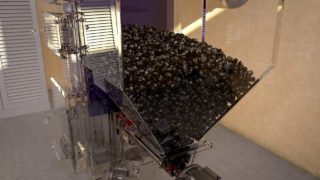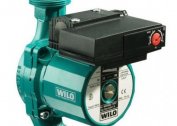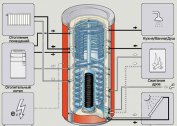Solid fuel heating devices operate on long-flame, stone, brown coal, anthracite and pressed briquettes. The popularity of equipment is associated with the low cost of installation work, the lack of the need for design documents. The coal boiler can be used for heating, hot water supply or cooking in the presence of a hob.
The benefits of operating a coal boiler
Modern automatic and semi-automatic models differ in a number of advantages:
- long work on one fuel tab - from 24 to 48 hours;
- economical consumption of fuel material - coal will need 1.5 times less firewood and 2-3 times less pellets;
- the ability to operate an automatic device for a week;
- cost reduction of 1 kW of thermal energy;
- profitability - coal fuel ranks second in terms of low cost after gas;
- Efficiency depending on the model - from 55 to 90%;
- insignificant amount of smoke during ignition - during operation it is not noticeable.
For laying in the furnace, you can use firewood, brown wood with a calorific value of from 4,500 to 7,000 kW / kg and anthracite with a calorific value of from 7,500 to 9,500 kW / kg.
disadvantages
When choosing a solid fuel unit, it is worth paying attention to the disadvantages of its operation:
- arrangement of a ventilated boiler room according to fire safety standards;
- labor costs for the organization of the chimney;
- the need for a dry compartment for storing coal;
- risks of chimney clogging and the possibility of cleaning it only with special installations and reagents;
- decrease in power of the device in the case of wet coal materials;
- volatility of boilers with forced draft type and automation.
The use of firewood and sawdust affects the power of the unit - the indicator drops by 25-30%.
The main types of coal-fired boilers
Coal radiators can be selected according to the principle of action and the method of burning fuel.
Auto Models
To control the unit uses a microprocessor connected to the regulation system. Automatic types of boilers operate on coal with fractions up to 50 mm, support long-term combustion by means of fan blowers. Combustion products are discharged through the traction system. Fuel loading is carried out automatically through the hopper using a screw conveyor. Features of equipment with automation include:
- reduction in the cost of heating - for 1 kW of heat you need to pay from 50 to 80 kopecks, depending on the region;
- profitability of coal consumption - 1.5-2 times less than standard models;
- efficiency - a real indicator of efficiency is 80-90%;
- complete combustion of fuel for 3-4 days after laying;
- equipping with a tank designed for 2-7 days of fuel use.
Smoke in automatic appliances is visible only at the time of ignition.
Pyrolysis Boilers
The difference between the pyrolysis coal boiler is a long-burning system. It is implemented through two furnaces. In the main, coal is burned, in the secondary, the pyrolysis gases are burned. The device operates as follows:
- Kindle Boiler The damper is opened completely, then using a small amount of dry wood, coal is ignited with fractions of 0.5-2 cm.
- Primary combustion of fuel.Enough 15-20 minutes.
- Transfer to pyrolysis mode. You will need to close the shutter and set the mode.
The pyrolysis reaction begins when the temperature in the furnace reaches 450-600 degrees.
Long burning
The design of the equipment is complicated by a heat exchanger above the furnace. The type of combustion also differs from standard options - coal begins to ignite from above. In comparison with direct combustion models, boilers differ:
- efficiency - fuel material is loaded 2 times less;
- using only dry coal to prevent condensation;
- the impossibility of refueling - weakly sintered rocks are recommended;
- re-bookmarking only with the complete combustion of the first.
The brand of coal is indicated in the manufacturer's instructions.
Direct combustion
Inexpensive options that you can heat a small house or cottage. The combustion process occurs from below, the fire gradually spreads through the firebox. Warm air masses move upward, heating the heat exchanger, and then the water type of the circuit.
For direct burning models, the maximum efficiency is from 70 to 75%. This is due to the slow heat transfer of the heated air masses and their quick removal through the chimney.
Materials for the manufacture of the housing
Manufacturers produce heating units in housings of various materials.
Steel
Inexpensive options are made of thin sheets. High-quality boilers are made of heat-resistant or high-carbon metal with a thickness of 4 mm. The advantages of boilers in a steel case include:
- resistance to fluctuations in temperature and pressure;
- ease of transportation and installation;
- maintainability - cracks are processed by the welding machine.
The disadvantages of the apparatus are the risks of corrosion of the heat exchanger, thinning and burning of the walls, the inability to increase power.
Cast iron
The boiler in a cast-iron housing is made on the basis of cast plates connected by a bolt method. Joints of parts are treated with heat-resistant sealant. Thanks to the design, sections can be added to increase power. The advantages of boiler plants include:
- resistance to corrosion;
- long-term operation - about 50 years;
- heat capacity due to the properties of cast iron and a small heat exchanger;
- maintainability - just replace or add a section.
The disadvantages of the cast iron body are cracking during temperature fluctuations, low efficiency and a one-way heat exchanger.
The main criteria for selecting a coal boiler
Coal boilers are the best option for houses where there is an individual type of heating main. When buying a unit, you need to consider several criteria:
- Efficiency indicator. In versions with direct combustion, it is 65-75%, with long-term combustion - from 78 to 84%, in pyrolysis - from 85 to 92%.
- Work offline. Only pyrolysis devices are fully autonomous.
- Fill up time. Coal is added to direct burning boilers once every 6-10 hours. In the presence of an automatic bunker, fuel is reported to the units of long-term combustion once every 2 days, and to the pyrolysis ones once every 4-7 days. Models without automatic equipment with a long mode of refueling every 12-18 hours, with pyrolysis afterburning - every 24-30 hours.
- Permissible fuel moisture. Long-term combustion systems are compatible with coal wet by 20-30%, direct - by 30-50%, pyrolysis - by 7-15%.
- The optimal size of the fractions. Coal 5–25 mm is placed in the pyrolysis boiler, 25–50 mm in long-term combustion, and 60–80 mm in direct combustion.
- The number of circuits. Devices that have one circuit can only be connected to the heating main.Double-circuit modifications work for heating, underfloor heating, are connected to the hot water supply.
- Firebox capacity. The larger the compartment, the less often you will need to lay coal.
- The presence of insulation on the outside. Insulated boilers retain more heat, do not break when the temperature jumps.
- The presence of the lining. A furnace with a lining is economical because depending on power, it consumes 25-45% less fuel.
- Safety system. It is provided by an external heat exchanger, an independent cooling circuit with an emergency thermal valve.
- The presence of a heater. The design of the combined units includes a heater, which will work after burning fuel and lowering the temperature of the coolant.
For the convenience of controlling and monitoring the temperature regime, the boilers are equipped with temperature controllers, weather-dependent devices, and self-cleaning systems.
The principle of operation of coal boilers
The standard coal-fired boiler has the appearance of a one-piece casing with lining. To reduce heat loss, a layer of insulating material is used.
At the front there are three compartments with smoke protection covers in the room. The lower compartment is an ash pan. On the rear panel below is an adjustable hole - it creates natural or forced traction. The central chamber is the firebox where coal is laid.
A grate is used to separate the lower and central compartments, create a direct current of air masses and remove combustion products. During the combustion reaction, streams of warm air through the pipes go to the upper compartment and heat the heat exchanger. Heated water is sent through pipes to the heating and domestic hot water. Temperature parameters are selected by a chain controller or an electronic mechanism.
Units with manual adjustment need to be laid 4-6 times a day, so it is problematic to control the temperature at night. Automatic boilers are equipped with an auxiliary fuel tank. From one bookmark coal can work up to a week. The temperature of the coolant does not change.
Installation specifics
Installation of solid fuel boilers is carried out without the permission of supervisory services. Users will need to follow a few rules:
- It is better not to install the unit in a living room - dust, soot and soot will be released. Installation in the corridor, bathroom, in the kitchen, in the bathroom is allowed.
- For models with a power of 60-150 kW on the basis of SNiP 42-01-2002, a boiler room with a volume of 15 m3 and with a ceiling height of 2.5 m is needed.
- Smoke exhaust and ventilation systems are organized without fail.
- Boilers with a capacity of up to 50 kW are put on a screed, more than 50 kW - on an individual concrete foundation with a protrusion of 25 cm from the body.
- Ventilation is done in the form of a supply hole opposite the boiler. A trellis hood is also required.
- The chimney is made of pipes with a cross section of 150-200 mm2. It should not have bends, inclinations.
- Binding is carried out using a bypass or a three-way valve set at a water temperature of 50-55 degrees.
- The optimum pressure parameter in the circuit is 1 bar.
The return and supply of the gravity line are directly led to the boiler.
User manual
Instructions for kindling and operating a coal unit are attached to each unit. Regardless of the manufacturer brand, there are general rules for using a direct combustion boiler:
- Melt the boiler by throwing some coal into the firebox.
- Lay paper and small chips on top of the rock.
- Light the paper. From it fire will go for firewood, then to the upper layer of coal material.
- After crusting, crush the top layer with a poker. This will facilitate the penetration of air to the lower layer.
Further work involves tipping coal, breaking down sintered pieces, and removing slag.
Coal type boilers - an economical solution for a private house and a cottage. Due to the long burning of fuel, a comfortable temperature is maintained for several hours. Before buying, you need to pay attention to the type of device and its characteristics.













